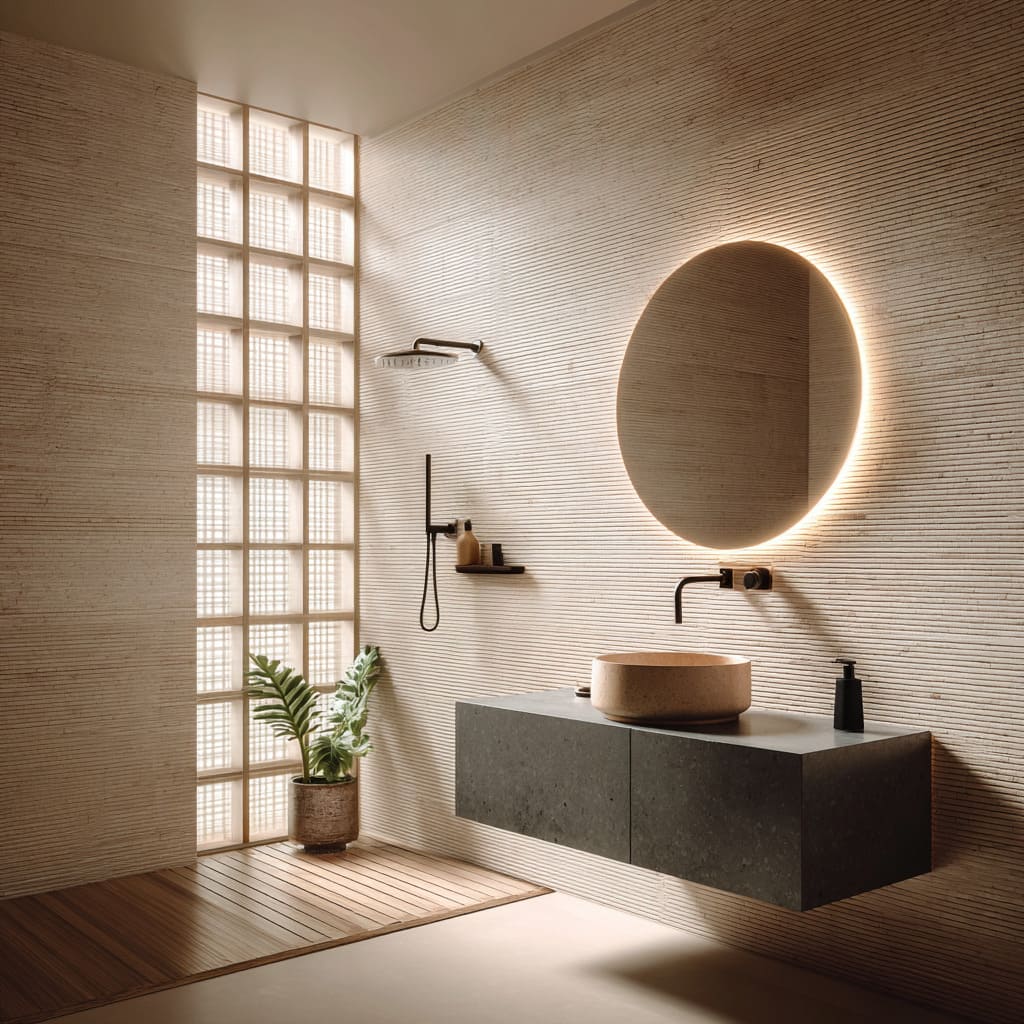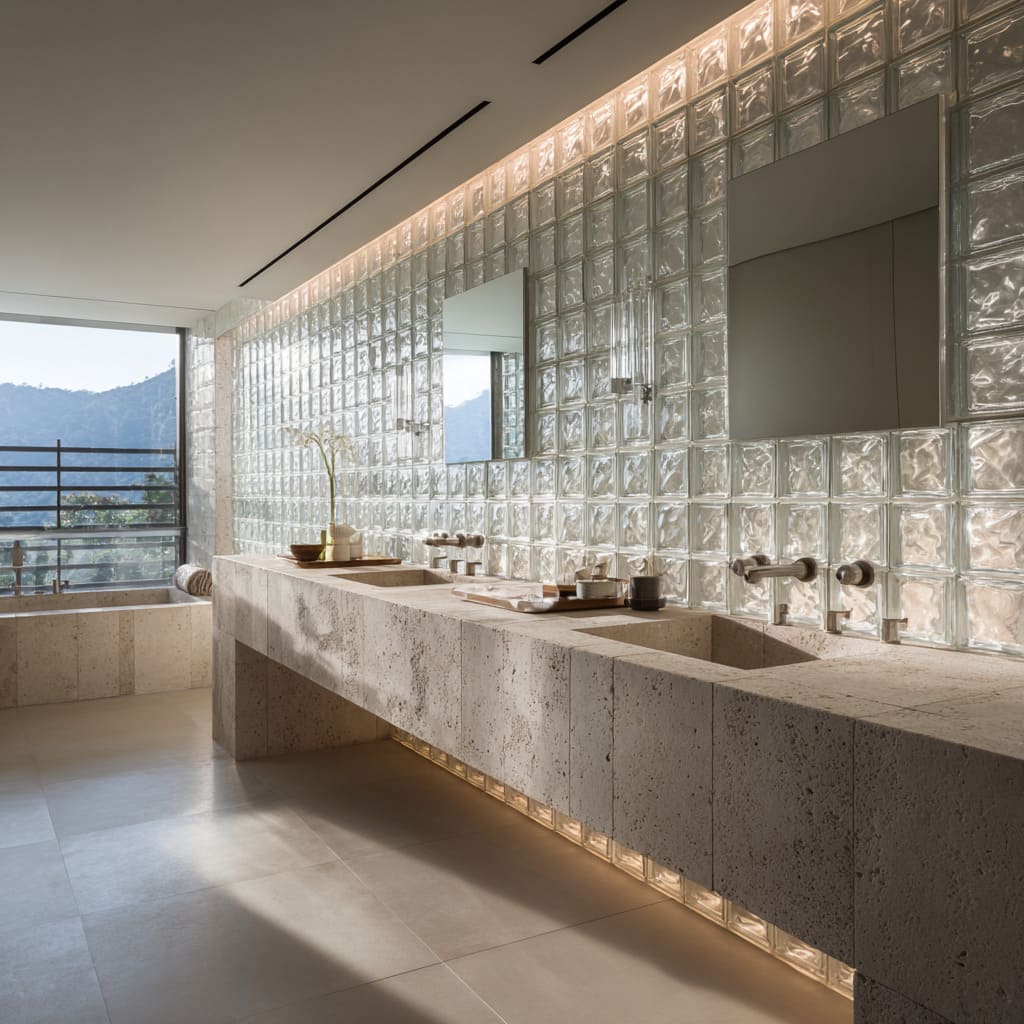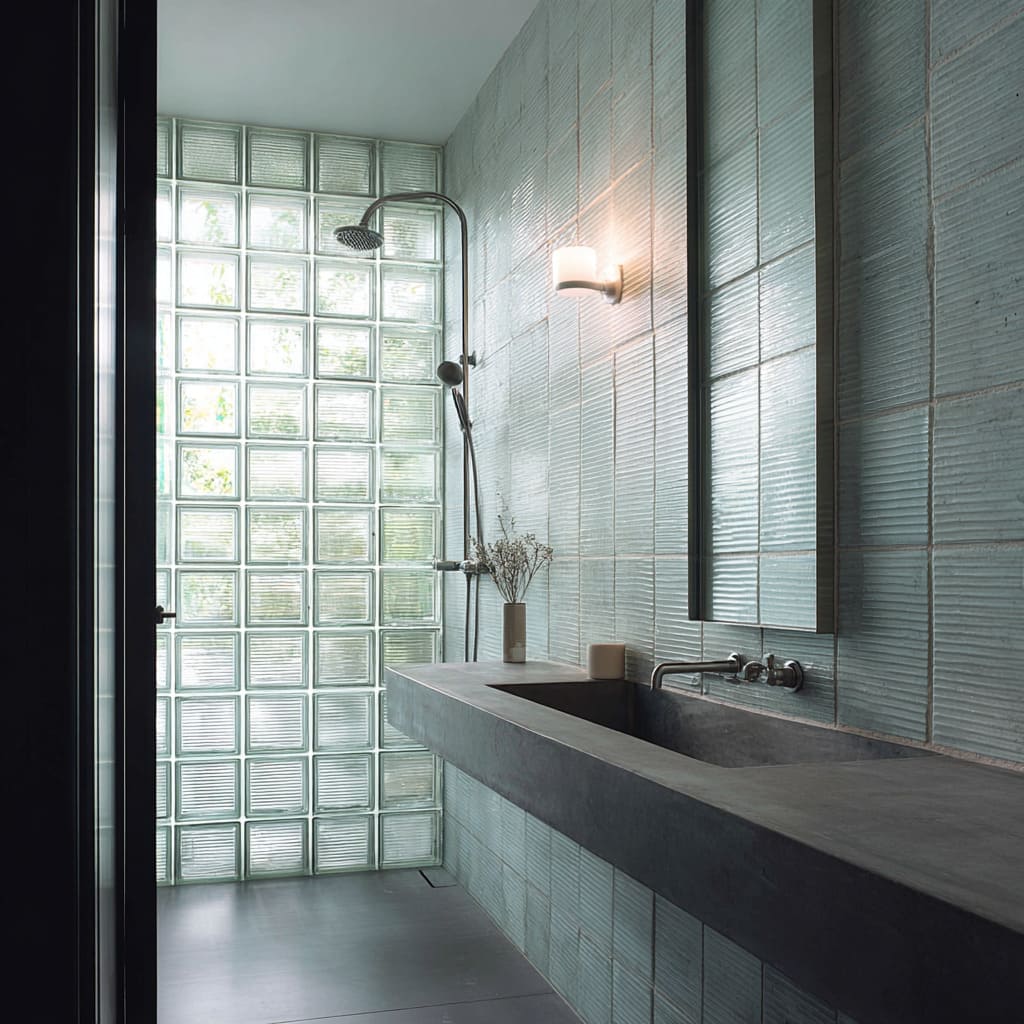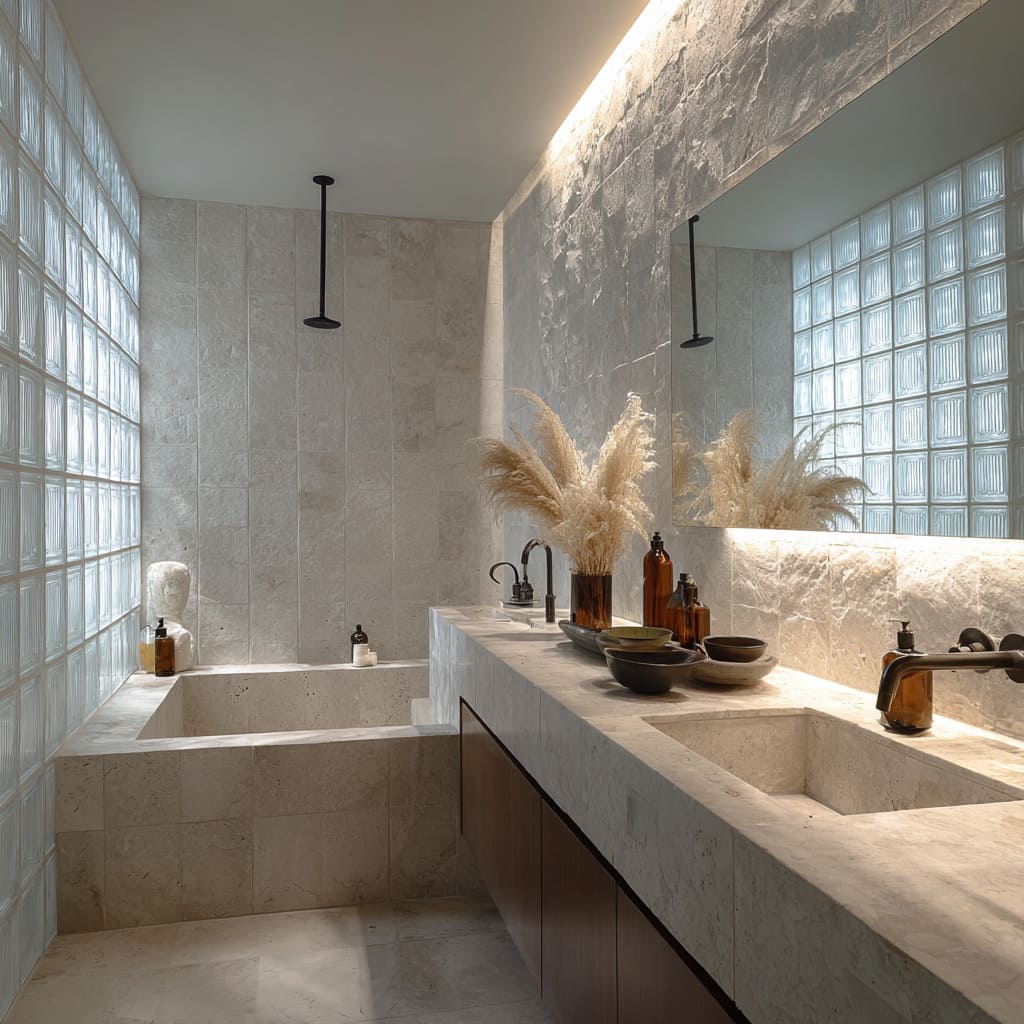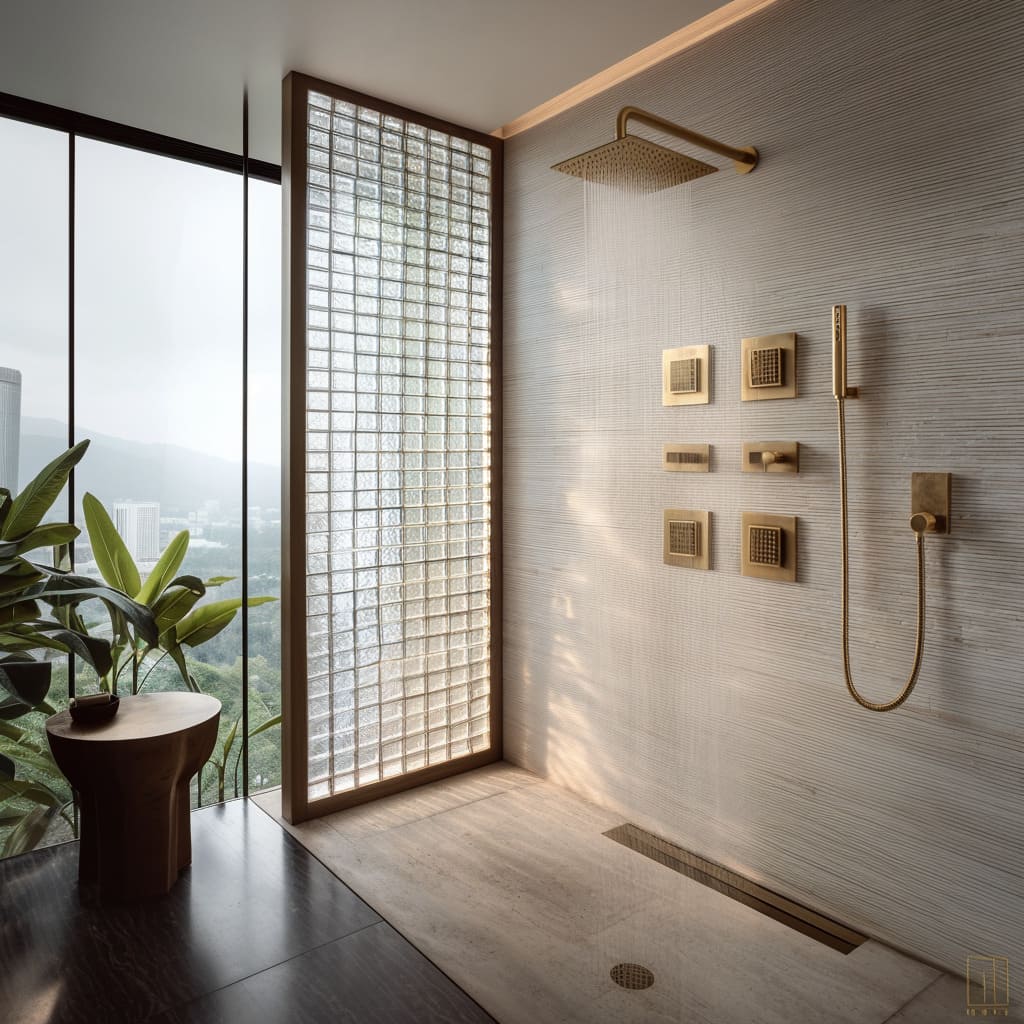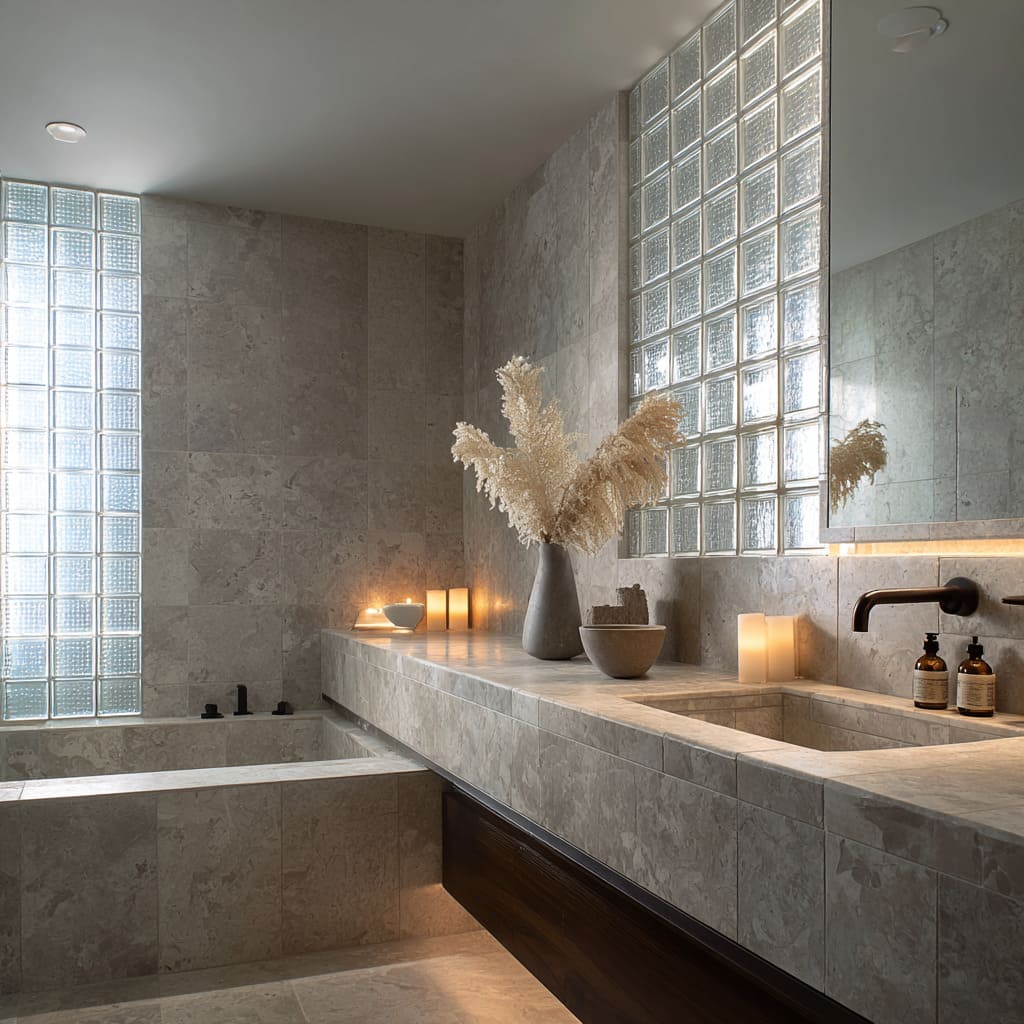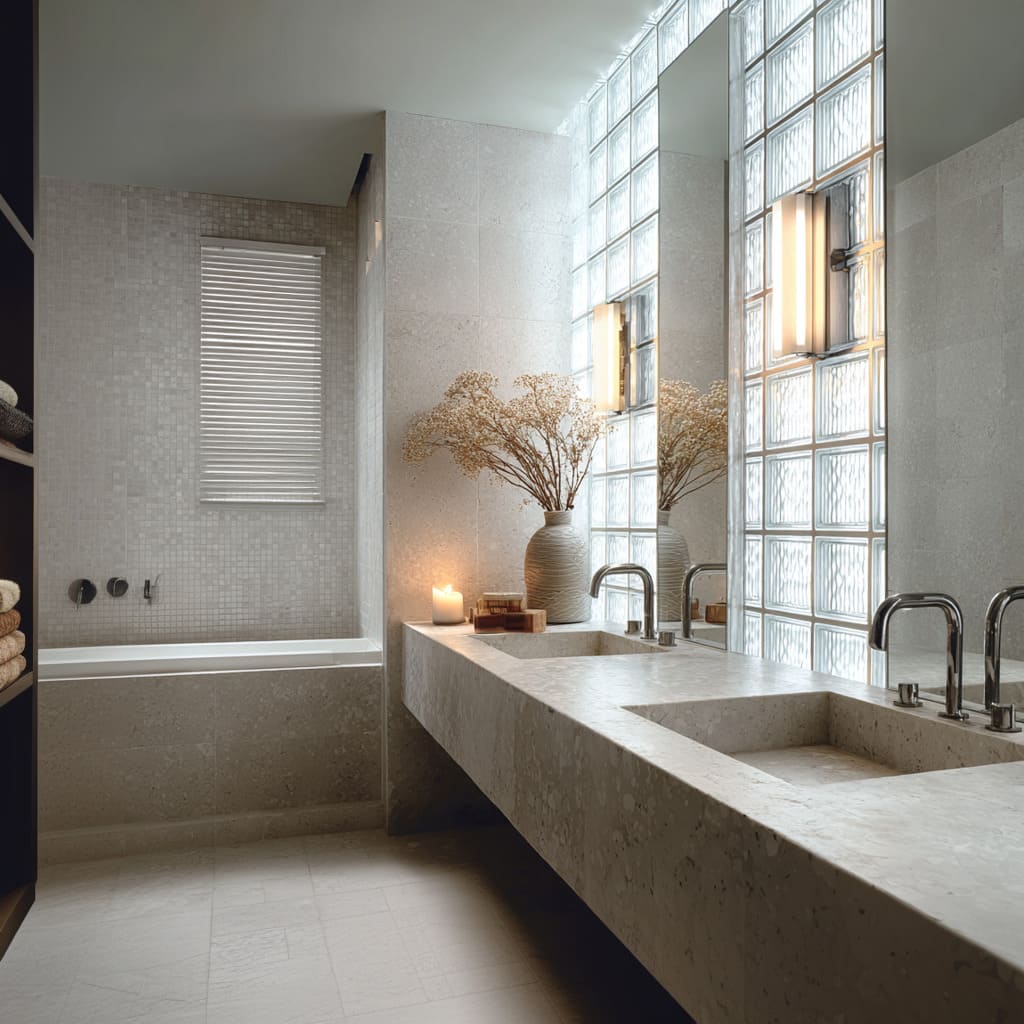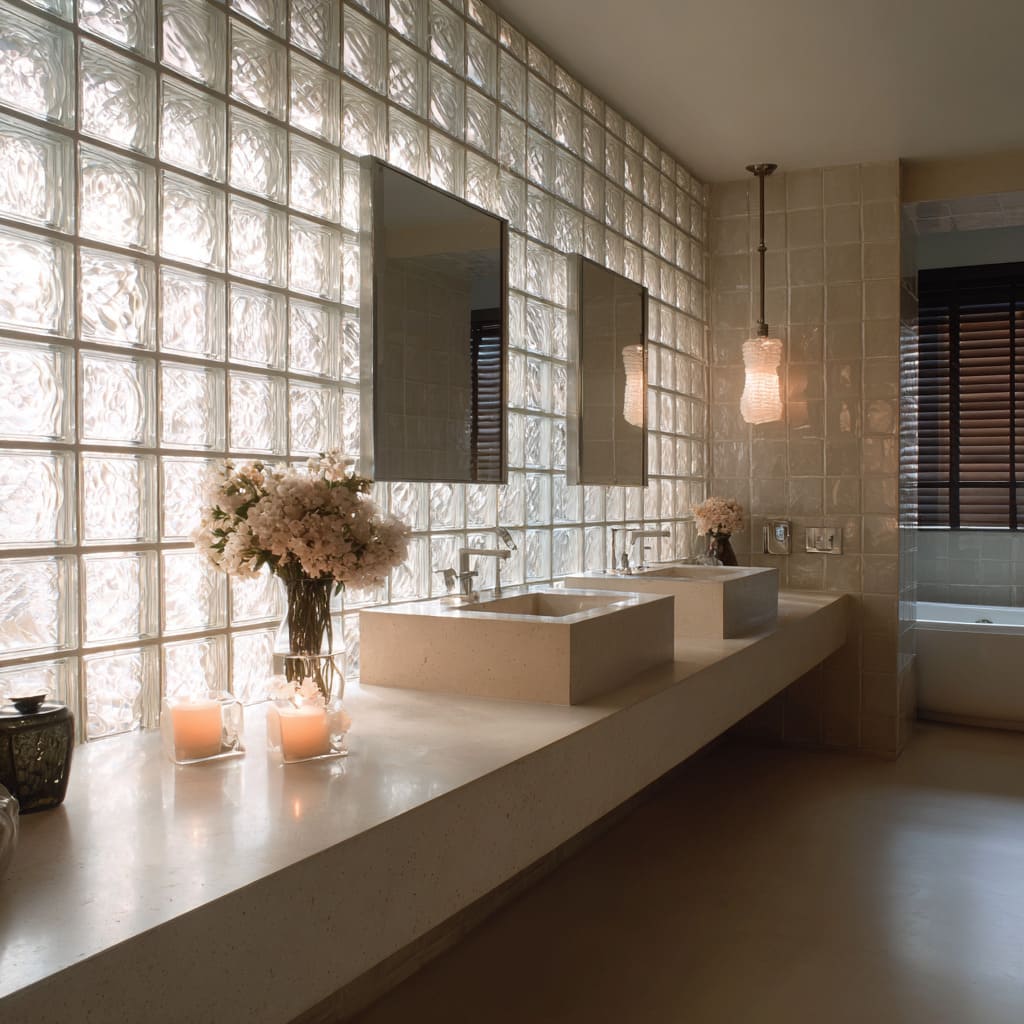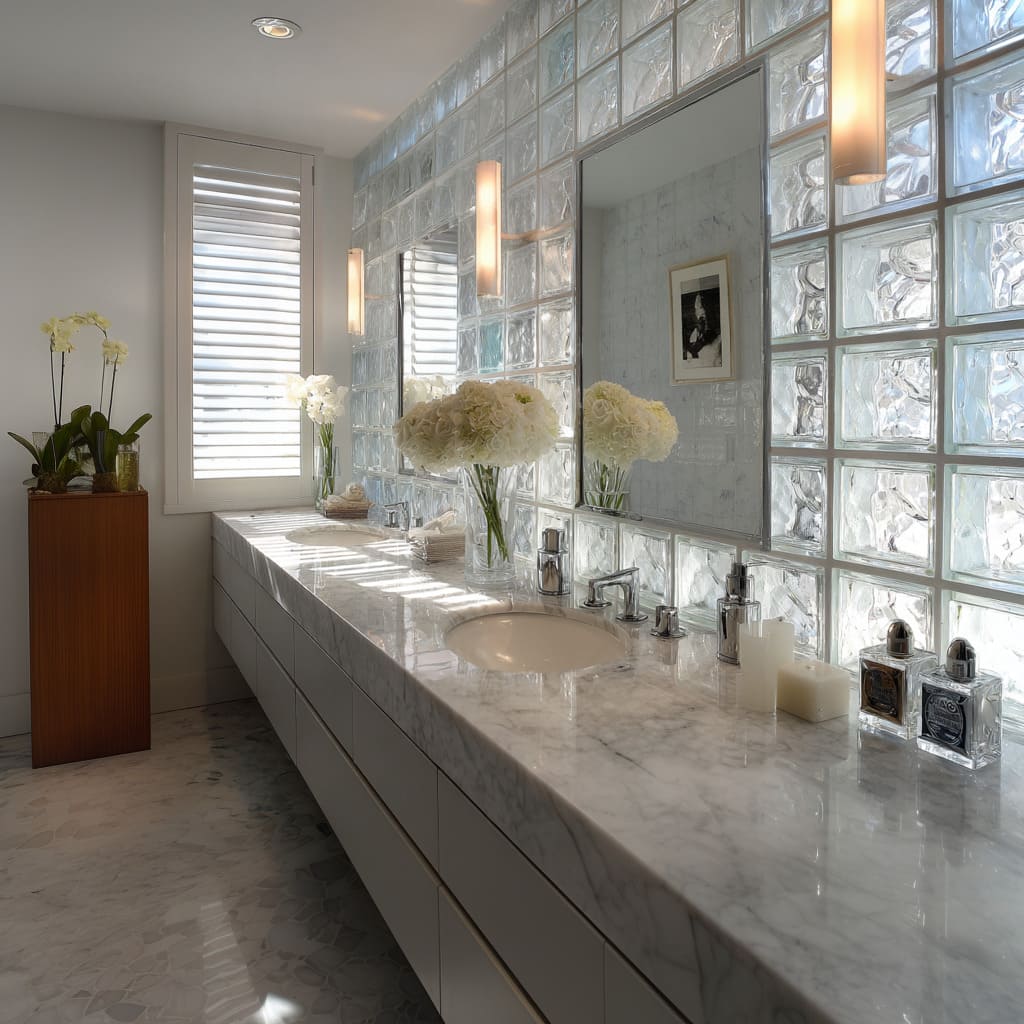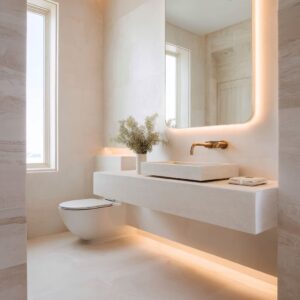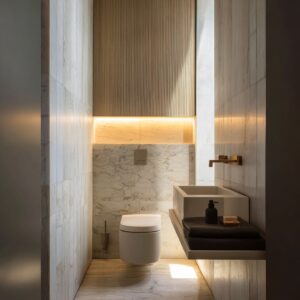Glass blocks shape a bathroom atmosphere in ways few other materials can. They glow, they filter, they distort, and they reflect, creating a light effect that shifts hour by hour.
In many current interiors, the blocks are less about nostalgia and more about treating the wall as a luminous surface with depth. The best glass block bathroom ideas rely on this soft, glowing backdrop.
Instead of acting like a simple window replacement, the blocks become an architectural light filter that reshapes the sense of space. They stretch long corridors, brighten low ceilings, and add a quiet shimmer to stone-heavy layouts.
The outcome is not a retro style but a calm yet visually layered space, where the glow arrives from a surface rather than a single source. This concept works across different moods—morning energy, afternoon softness, or a tranquil evening look—because the glass grids carry both daylight and warm artificial lighting with equal ease, creating a flexible lighting environment that responds to the time of day.
The Grid as a Silent Organizer of Fixtures, Shadows, and Reflections
One of the strongest design insights is how the block grid serves as a silent structure that organizes everything around it. Mirrors, wall sconces, floor drains, shower bars, and even perfume bottles fall into rhythmic alignment with these joints.
This isn’t about perfect symmetry; it’s about using the grid to calm the visual field so the room feels controlled without feeling rigid. Designers often support the block grid with additional layers of subtle pattern:.
Layered patterns that work together
- vertical ribs on tiles,
- horizontal blind shadows,
- wide stone slabs with long, slow veins,
- slim metal fixtures appearing as sharp, drawn lines.
These secondary rhythms do not overpower the grid; they add scale variation. The tiny blocks form the “fast pattern,” the ribbed tiles form a “medium tempo,” and the large stone pieces form a “slow beat.
” This multi-scale layering gives the room a depth that reads subconsciously, making the square joints feel intentional instead of overwhelming. The result is a visually balanced room that uses multiple patterns without any contrast that feels loud or forced, a fundamental idea behind refined glass block shower designs seen today.
Spatial Effects: Stretching, Floating, Blurring, and Framing Light
A major strength of glass block bathroom designs is how easily they manipulate space without changing the footprint. Designers use blocks to guide the eye toward the end of the room, create illusions of floating slabs, and blur depth so the room feels larger.
Spatial moves commonly used with blocks
- End-wall glow: a full block surface at the far end turns a narrow layout into a light corridor.
- Floating slabs: a stone counter pulled off the floor feels weightless when sitting in front of the glowing grid.
- Reflected grids: mirrors set flush to the blocks create a visual “continuation” of the squares, like the wall extends past its physical boundary.
- Softened edges: distorted views through the blocks give the impression of a garden, a tree, or a silhouette shifting outside the room.
These moves reshape perception without resorting to bold colors or big decorative pieces. When a designer wants a room to feel like a suite in a spa resort or a boutique hotel, the combination of reflection, glow, and blurred depth accomplishes it naturally.
This approach also supports glass block shower ideas where the shower becomes a zone of filtered daylight rather than a fully enclosed stall.
Stone, Timber, and Warm Light as Counterweights to Translucent Surfaces
Glass blocks often carry a slightly cool tone. To balance that coolness, interiors pair them with warm materials, soft lighting, and earthy textures.
A common pairing is pale limestone, cream terrazzo, chalky beige tiles, or soft grey stone—materials with a gentle natural irregularity that counteracts the smoothness of glass. Timber bases under floating vanities introduce warmth without dominating the palette.
Slim brass or black fixtures add quiet graphic accents. Warm pendants and indirect lighting create small pockets of glow that soften the cooler wall.
In rooms with a full block wall behind the tub or vanity, designers often add a thick stone slab, a monolithic basin, or a deep tub block to ground the composition. The mix of heavy mineral volume and shimmering glass generates tension that feels calm instead of busy.
These combinations create modern environments where the blocks function like a light sculpture and the stone behaves like a steadying foundation.
Light as a Material: Direct, Reflected, Multiplied, and Transformed
The light behavior in such bathrooms is unusually complex because glass blocks multiply every beam. Daylight enters as fragmented highlights; warm sconce light bounces across several rows of glass; reflection inside individual blocks creates tiny echoes.
Even a single candle can appear dozens of times at different intensities. Designers rely on this “light multiplication” to enrich the room without adding more fixtures.
The effect becomes striking in layouts where pendants hang in front of the blocks, because the pendant appears three times: the actual object, its reflection in the mirror, and its softened shadow inside the blocks. This layered glow functions almost like a lighting design trick, creating ambiance without technical systems or colored LEDs.
It is also what makes modern glass block shower wall ideas visually strong even when the materials remain neutral and understated. In evening settings, the glass becomes a shimmering veil with warm pockets of brightness floating above or beside the primary stone forms.
Glass Blocks as Screens, Columns, Doorless Dividers, and Shower Boundaries
Glass blocks are not always used as full walls. Modern designers divide them into several typologies that shift both the mood and the spatial logic:.
Full glowing boundaries
Used behind tubs or vanities, these walls behave like large-format light surfaces.
Vertical light wells
Slim, floor-to-ceiling columns in corners create lantern-like accents that illuminate shower edges or vanity sides. These positions are subtle yet powerful additions to glass block shower designs in luxury or spa-inspired interiors.
Backlit grooming zones
Panels behind tall mirrors make the mirror appear weightless while giving the room a quiet glow.
Framed block screens
Using a warm wood frame converts the blocks into a translucent door-style plane that filters views toward a window or city skyline. This approach is often seen in glass block doorless shower designs, where privacy and openness coexist.
Block-wrapped corners
Where blocks turn a corner, the boundary feels more like a soft architectural veil than a wall, giving the room a sculptural character. These typologies reflect how contemporary design sees blocks—not as retro decorative units, but as sculpted light filters that shape space.
This is especially clear in layouts where a block panel acts as a boundary for glass brick shower ideas that rely on soft light rather than solid partitions.
Vegetation, Still Life Objects, and Ritual Elements
Most of the design concepts place natural elements or small objects at very specific intersections where the blocks meet stone. Branches, pampas grass, ferns, soft blooms, and even outdoor silhouettes faintly visible through the glass soften the geometric structure.
These touches are not placed randomly; they appear at junctions where the light intensifies or where the material changes. This includes the junction between the glowing blocks and the counter slab, the corner of a tub ledge, or the meeting of a ribbed wall with a glass panel.
A small plant near a block column becomes a focal object because its leaves catch fractured highlights. A candle on a stone edge produces dozens of reflections.
A black vase placed against the blocks becomes a grounding shadow in an airy field of light. This interplay between nature and geometry creates a serene, highly composed environment where each element contributes to the room’s balanced rhythm.
This is one of the reasons bathroom glass block window ideas continue growing in popularity across contemporary interior design.
Mood Typologies: The Five Emotional Directions of Glass Block Bathrooms
The concepts studied in this article fall naturally into several mood categories. These can be understood as emotional typologies rather than design instructions, and each typology uses the blocks differently.
a) The corridor glow
A full end wall of blocks elongates the room and makes it feel like a light-filled passage.
b) The stone altar
A thick monolithic counter or tub sits in front of a shimmering wall, giving a quiet ritual feeling to daily routines.
c) The spa lantern
A slim column or framed block panel acts like a tall glowing lamp in a room of stone and plants.
d) The atmospheric stage
Blocks behind mirrors and sconces multiply warm light so the grooming zone reads like a quiet performance space.
e) The outdoor filter
Blocks positioned beside large windows create a gradient from clear view to softened privacy, blending inside and outside.
Each category can shift with lighting, objects, or tone of materials. This flexibility is why bathroom glass block design is seen across interiors that want a sculptural yet soft presence without bright colors or ornate decoration.
Modern Showers: Shapes, Textures, and Light Behavior
Using blocks inside the shower area changes the entire atmosphere of bathing. A block wall can create the impression of showering beside a bright courtyard or a softly filtered window.
In many concepts, the blocks have rippled or striated interiors that distort the view and turn sunlight into glowing patches on the floor. Shower fixtures remain slim, graphic, and calm—thin rails, polished metal lines, or matte finishes that appear like drawn strokes on a textured field.
Plants or small ledges near the block wall reinforce the softness of filtered daylight.
This approach creates strong visual identities for glass block wall shower designs, where the shower zone functions like its own glowing corner, distinct from but visually connected to the main vanity. A similar strategy appears in glass block bathroom wall ideas, where the block surface becomes a full-height backdrop for everyday rituals.
In shower designs where the blocks form the boundary instead of a door, the layout naturally supports glass block doorless shower designs, which join privacy and brightness through translucency rather than hardware. Even when blocks occupy a smaller portion, they still guide the atmosphere because the pattern, glow, and shadow behavior feel consistent throughout the bath.
Conclusion
Modern interiors use glass blocks not as nostalgic accents but as instruments of light, geometry, mood, and depth. Through grids, reflections, pattern layering, and careful interplay with stone and natural elements, they create bathrooms that feel quiet yet visually rich.
These ideas support environments ranging from bright morning suites to soft evening retreats, and they show how the smallest units—square blocks of translucent glass—can transform the largest sensation: the feel of the entire room.

